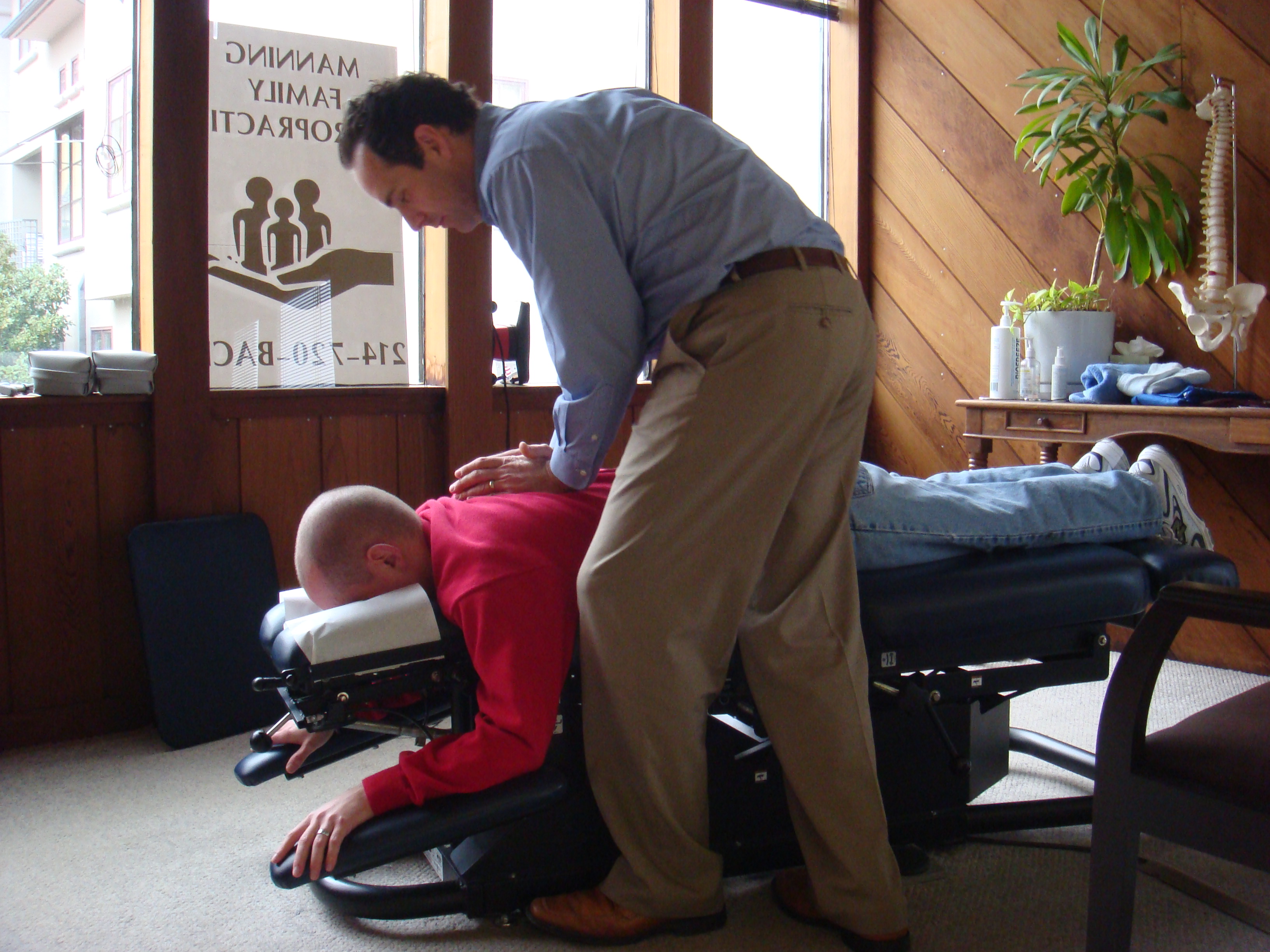For our veterans and families
That shoulder pain may really be a pain in the neck
There’s a reason why Dr. Jeff Manning of Manning Wellness Clinic is the go-to chiropractic health expert in the Dallas/Fort Worth area. As a knowledgeable professional with more than 15 years of clinical experience, Dr. Manning is known for his ability to talk honestly and openly to his patients; answer questions in a easy-to-understand style; and teach the benefits of chiropractic. Please read below where Dr. Manning talks about that pain in your shoulder that may really be a pain in the neck.
——————————-
SPECIAL FOCUS: BACK AND JOINT HEALTH
By DAPHNE HOWLAND
Special Contributor to the Dallas Morning News
Published: 04 November 2013 04:03 PM
Common complaint
Pain in the neck and shoulder is extremely common because their complex workings are vulnerable to age-related changes, poor posture, lack of exercise and stress.
Degenerative disk disease, an ominous term, happens to everyone starting about age 20. Disks, which cushion the vertebrae, aren’t able to hold as much water, which makes them more delicate, Young says. Meanwhile, tendons in the shoulder’s rotator cuff start changing about age 40.
As those parts lose resilience, stressors like underuse or overuse of muscles and tendons and even emotional stress can cause strain or injury.
 Posture is the problem for most people, says Jeffrey Manning, a chiropractor who owns the Manning Wellness Clinic in Dallas. “People look down at their computer, their phones. So the muscles in the front of the neck will start to become shortened and less flexible, and across the shoulder blades they’ll become stretched, but not in a good way. It’s like trees leaning into the wind.”
Posture is the problem for most people, says Jeffrey Manning, a chiropractor who owns the Manning Wellness Clinic in Dallas. “People look down at their computer, their phones. So the muscles in the front of the neck will start to become shortened and less flexible, and across the shoulder blades they’ll become stretched, but not in a good way. It’s like trees leaning into the wind.”
This begins a cycle that can change joints and bones as they react naturally to the physical demand. “Good stress, like healthy exercise, strengthens bones. But if you stress bones in an imbalanced way, they react in an imbalanced way, and that messes up the mechanical balance of the working joint,” Manning says.
The stress of busy, complicated lives or the emotional toll of bad days or sad life events are often manifested in stiff muscles in the neck and shoulders. Stress hormones worsen the problem, Young says.
“Your muscles get knotted up by very real physical tenseness,” Young says. “But the stress is twofold: Your stress does tend to be carried in the form of shortened muscles in the neck but it also changes the biochemical markers in the body. The same chemicals that are released when you are in stress or in pain are fuel for the pain of muscle tension.”
When to see a doctor
Moen says he wishes he’d gone to a doctor after six months of suffering rather than two years. But Young says to go after more like six weeks.
For one thing, she says, studies show that chronic pain can rewire the brain so that discomfort continues even after the cause is resolved. Plus, many issues can be addressed with conservative measures such as physical therapy, ergonomic changes to the workplace, exercises, modified activity and medication — as long as the problem is accurately diagnosed and caught early.
For stiffness without pain, seeing a doctor may not be necessary. But it’s probably a signal to make changes, these experts say: Be sure you work at a computer with your neck in a neutral position. Exercise regularly; the blood flow helps keep muscles and tendons healthy. Don’t constantly look down at your phone; look up and enjoy the scenery.
“It may start out as a posture issue. Then after six months or a year it becomes a matter of the joints just not working properly anymore,” Manning says. “Your body is such an intricate machine.”
The Single Best Thing you can do for your Health
A great video to watch and share. Well worth the time. It’s about 9 minutes total. It’s also a great follow up to my post about the Hotter than Hell ride I did this summer.
Chiropractic for Cancer Patients
Note from Dr. Manning: I believe strongly that cancer patients benefit from chiropractic care. Chiropractic can help to alleviate pain and discomfort; assist with the absorption of medication; and allow your body to function more efficiently, therefore strengthening your body’s ability to fight disease. Chiropractic can not cure cancer, but it can help in a patient’s battle with the effects of this insidious illness. If you or a family member are fighting cancer, please schedule a time to speak to me personally. https://manningwellness.com/schedule-a-free-consultation/
Cancer Treatment Centers of America Highlighted in ACA News Cover Story
Groundbreaking, Integrated Approach to Treatment Demonstrates Commitment to Patient-centered Care
Arlington, Va.—The American Chiropractic Association (ACA) today announced that Cancer Treatment Centers of America (CTCA)—a pioneer in integrative care, incorporating chiropractic services and other supportive therapies into its advanced, evidenced-based cancer treatments—is the focus of the cover story in the August 2013 issue of ACA News.
At CTCA’s five regional hospitals, chiropractic physicians work on teams alongside surgeons and oncologists to support cancer patients during their treatment. Its patient-centered approach came from a simple question, “If your mother had cancer, how would you want her to be treated?” CTCA’s founder, Richard J. Stephenson, lost his mother to cancer and wished that her treatment had been more focused on providing comprehensive care in addition to the advanced treatment options she needed.
Chiropractic physicians joined CTCA’s staff 10 years ago (due to patient demand), allowing its hospitals to offer truly comprehensive, integrated treatment under one roof. If a patient complains about a headache due to a new chemotherapy drug, his or her treatment team might first suggest the patient try a chiropractic adjustment as opposed to going on yet another medication.
According to Jeffrey Sklar, DC, eastern regional director in the department of chiropractic at CTCA, “We are not treating cancer, we are treating patients with cancer; it is whole-person care. And that is what got me turned on about chiropractic to begin with.”
CTCA’s model has influenced the way oncologists, surgeons and other clinicians around the country think about treating cancer patients. Whole-person cancer treatment combined with a compassionate, nurturing environment—known as the Mother Standard of Care—provides patients with much needed support during treatment.
“I applaud CTCA as an institution for its dedication to treating the whole patient by offering therapy aimed at combating the difficult side-effects of grueling cancer treatments, as well as the cancer itself,” said ACA President Keith Overland, DC. “I am truly inspired by my colleagues at CTCA, who are making a real difference in the quality of life for people undergoing cancer treatment.”
The August 2013 issue of ACA News, featuring more on chiropractic’s role in supporting patients at CTCA, and CTCA’s important support for the chiropractic profession and partnership with ACA, is available on ACA’s website. ACA News is the association’s flagship publication.
The American Chiropractic Association (ACA), celebrating its 50th anniversary in 2013, is the largest professional association in the United States representing doctors of chiropractic. ACA promotes the highest standards of patient care and professional ethics, and supports research that contributes to the health and well-being of millions of chiropractic patients. Visitwww.acatoday.org.
###
JAMA suggests Chiropractic before Surgery for Back Pain
Chiropractic Physicians Provide Natural Alternatives for Pain Treatment, Injury Prevention
May 8, 2013, Arlington, Va.—An article in the Journal of the American Medical Association (JAMA) suggests patients try chiropractic services for the treatment of low back pain. According to the article, surgery is not usually needed and should only be considered if more conservative therapies fail. The information in JAMA reinforces the American Chiropractic Association’s (ACA) position that conservative care options should serve as a first line of defense against pain.
The article, part of JAMA’s Patient Page public education series, explains that the back is made up of bones, nerves, muscles and other soft tissues such as ligaments and tendons that support posture and give the body flexibility. Back pain can be caused by problems with any of the structures in the back.
As neuromusculoskeletal experts, chiropractic physicians are particularly well suited to manage and help prevent low back pain.
“We are encouraged to see JAMA suggest patients try chiropractic and other more conservative types of treatment for their back pain. In many cases pain can be alleviated without the use of unnecessary drugs or surgery, so it makes sense to exhaust conservative options first,” said ACA President Keith Overland, DC.
“Research confirms that the services provided by chiropractic physicians are not only clinically effective but also cost-effective, so taking a more conservative approach at the onset of low back pain can also potentially save both patients and the health care system money down the line,” he added.
For those who are currently pain-free, the exercise tips, posture recommendations and guidance on injury prevention routinely provided by chiropractic physicians can help people maintain a healthy back throughout their lives. To learn more, contact Dr. Jeff Manning for a FREE PHONE CONSULTATION at Manning Wellness Clinic
2702 McKinney Avenue, suite 202
Dallas, TX 75204
214-720-2225
www.manningwellness.com
Manning Wellness Clinic’s Top 5 Tips for Avoiding Weekend Gardener Syndrome
Spring has sprung! Warmer weather brings visions of homeowners manning the bbq, napping in their hammocks, and enjoying their backyard paradise, the one that has collected piles of leaves, sprouting weeds, dead branches and debris over the winter months. With fervent vigor, the weekend garden warriors head outside and attack their yards. Frequently, injuries result as muscles long-dormant during the winter months experience much more activity in a brief period of time than usual. Since the height of muscle pain typically sets in about 36 hours after strenuous activity, our office phone starts ringing first thing Monday morning. As we all know, it’s hard to sit immobile at a desk all day when your lower back (or neck, shoulders, knees, etc.) are screaming in pain. Your backyard may look amazing, but your back may pay the price.
Here are the Top 5 Tips for Avoiding Weekend Gardener Syndrome from Dr. Jeff Manning of Manning Wellness Clinic in Dallas:
1. Bend your knees: Weeding, one of the most labor-intensive outdoor jobs, is responsible for more low-back injuries than almost any other springtime activity. Repeatedly pulling at stubborn weeds fatigues the lumbar muscles and can strain ligaments and discs. With your back in an already compromised, bent-forward position, and your legs likely straight, one good yank at a tough weed may be enough to bulge a disc or misalign your pelvic bones. A half-kneeling position, or better yet, a narrow blade shovel, is a much safer/easier way to deal with weeds.
2. Avoid Heavy Lifting: Moving lawn and patio furniture, hauling bags of mulch or seed, planting new shrubs…often requires heavy lifting. Whenever possible, grab an extra set of hands to help with awkward or heavy items. Or pull out the trusty wheelbarrow or hand trolley. If you must lift, don’t forget to bend your knees, and keep the load as close as possible to your core, to take some pressure off of your lower back.
3. Pace yourself: Your yard does not need to be completed in a day! Breaking up the planting into small increments minimizes your risk of injury and maximizes your chance of a gorgeous garden. Hours of planting increases your risk of strained muscles, ligaments or other tissues. When a muscle becomes fatigued, its ability to stabilize a joint or create enough force to accomplish a routine task diminishes considerably. Raking is a perfect example since it requires you use large, postural muscles in your back. Tip: Take it slow and steady, and make sure to switch sides frequently so that you try to work your body evenly on both sides. Many injuries result from overly tired muscles. Listen to your body; if it’s telling you that it’s getting tired and something is starting to hurt, stop! Your body is communicating that it needs a break and if you don’t listen, it will just yell louder. By changing activities every 30 minutes, repetitive strain risk is decreased.
4. Don’t trim what you can’t reach: Pruning hedges with heavy sheers is an easy way to acquire rotator cuff tendonitis. It also puts your back at risk for injury. Over extending your arm with a heavy object in your hand is a quick recipe for a tendon injury. When trimming back bushes, keep the sheers close to your body and try to keep your shoulders at or below ninety degrees of elevation. This position protects the delicate rotator cuff from tearing and also protects your back.
5. Use the right tools for the job: Just like buying the right gear for an exercise program, buying the right tools for yard work can be just as important. Some better rakes and shovels are ergonomically designed so they better fit your body. Make sure your hand fits comfortably on the handle to avoid blisters and wrist strain. Also look for rakes and shovels which you can comfortably manage rather. Lastly, use the right tool for the job: Don’t try to use a snow shovel to dig a hole for a shrub.
New Research: Chiropractic Patients Less Likely to Undergo Lumbar Surgery
 Newly published research reinforces our belief at Manning Wellness Clinic that Chiropractic is often the most effective, least invasive and least costly treatment for lower back pain.
Newly published research reinforces our belief at Manning Wellness Clinic that Chiropractic is often the most effective, least invasive and least costly treatment for lower back pain.
Chiropractic Patients Less Likely to Undergo Lumbar Surgery
New Studies Support the Chiropractic Profession’s Conservative Approach to Health
Arlington, VA.—A recent study in the medical journal Spine found a strong association between chiropractic care and the avoidance of lumbar spine surgery. Manning Wellness Clinic and The American Chiropractic Association are encouraged by this and other recent research supporting chiropractic’s conservative, less costly approach to low-back pain.
Key findings of the Spine study show that:
• Patients under age 35, women, Hispanics and patients whose first provider was a chiropractic physician had reduced odds of lumbar spine surgery
• Approximately 43 percent of patients who saw a surgeon first had surgery
• Only 1.5 percent of those who saw a chiropractic physician first ended up having surgery
Two additional studies reinforce ACA’s longstanding position that health care providers should start with conservative approaches to treatment, such as the services provided by doctors of chiropractic, before guiding their patients to less conservative alternatives. Such an approach benefits patients and cuts health care spending—especially for a condition as common as low-back pain.
Dr. Jeff Manning with Manning Wellness Clinic in Dallas says, “I can’t even begin to count the number of my patients who, by receiving regular chiropractic adjustments, were able to completely avoid surgery and all of the risks associated with it. I always tell patients to exhaust every non-invasive option before heading under the knife. That’s not to say that there are many instances when surgery is necessary, but there are many, many more times when it can be avoided.”
A recent study in Medical Care found that adjusted annual medical costs among complementary and alternative medicine (CAM) users was $424 lower for spine-related costs, and $796 lower for total health care cost than among non-CAM users. Furthermore, CAM treatments were cost neutral to health care systems, meaning that CAM users did not add to the overall medical spending in a nationally representative sample of patients with neck and back problems.
Published in The Lancet, “The Global Burden of Disease 2010,” authored by an international group of experts assessing the world’s biggest health challenges, underscores the need for better solutions to back pain and other musculoskeletal conditions. The massive survey indicates that while people may be living longer they are doing so more frequently with disability. The study identifies musculoskeletal conditions as the second leading cause of disability, and cites low-back pain as one of the major contributors to disability worldwide. GBD authors noted that creating effective and affordable strategies to deal with the rising burden of non-fatal health outcomes should be an urgent priority for health care providers around the world.
“As governments and health systems around the globe search for answers to complicated health challenges such as rising numbers of chronically ill and disabled patients and runaway costs, research is finally demonstrating what the chiropractic profession has promoted for years: that caring for patients with conservative treatments first, before moving on to less conservative options or unnecessary drugs and surgery, is a sensible and cost-effective strategy,” said ACA President Keith Overland, DC.
Tech-Neck: Expert Offers Tips for Reducing and Avoiding Pain and Injury
Dr. Jeff Manning, a leading expert on a new technology-related discomfort called ‘tech-neck’, is featured in an interview on WFAA-TV in Dallas.
Click to watch: Tech-neck is a growing problem, but Chiropractic can help
Tips from Dr. Jeff Manning, Manning Wellness Clinic; How to Reduce or Prevent Handheld Device Related Pain:
- Limit the amount of time and frequency that you use your device. If you have to use it for an extended period of time, take breaks. Rule of thumb: Take a 5-minute break for every 15 minutes you use your device, and don’t type for more than 3 minutes straight. Get up and walk around to stretch your muscles. One simple exercise is to tilt your head to one side (ear to shoulder) then to the other side, back to neutral, turn to look all the way to the right, then left. Back to neutral, then lean head back and back to neutral. Do all without raising shoulders. Don’t stretch forward…this only accentuates the poor posture your trying to avoid. Do it slowly, without straining. Repeat.
- Be aware of your posture. Pay attention to how you hold your device. Try to keep your wrists straight and upright. Loosen your grip when possible. Alternate the fingers you use to type; if you most often use your thumbs, try to switch to your index finger as it allows you to keep the hands more relaxed.
- Use a tablet holder: There are many on the market, but all have the common goal of securing the tablet at a height that is designed to reduce your need to keep your head bent down and forward. Keeping your device at eye-level will help to reduce neck pain and possible damage. It can also prevent what is know as “text-neck” or head-forward posture.
- Listen to your body: If you are experiencing pain in your neck, back, shoulders, hand…or eye-strain, pay attention. Those aches and pains have a source, and in this case, it may be technology. Overuse of handheld devices can also exacerbate an existing or old injury so be aware of what you are feeling. Don’t’ fall into the trap of, ‘If I ignore it, maybe it will go away’.
- Seek help: If you are experiencing discomfort, don’t wait, seek professional help.
Dr. Jeffrey Manning, DC
Manning Wellness Clinic
2702 McKinney Avenue, suite 202
Dallas, TX 75204
214-720-2225





